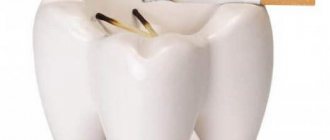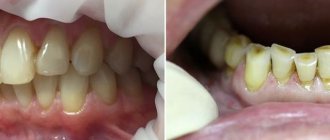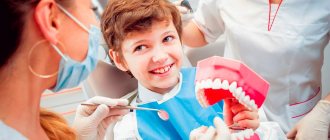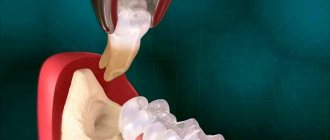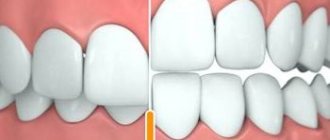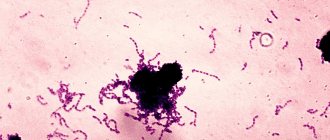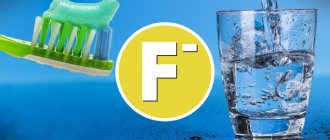Malocclusion is a problem that many people face. The most common type of orthodontic structures remains braces. Correcting a bite with braces can take more than one year, but what to do if caries has developed under the structure, and why could this even happen?
Caries is a pathology in which the tooth is destroyed under the influence of cariogenic microorganisms. Pathogenic microflora found in the oral cavity secrete acids that have a destructive effect on the enamel. The result of this whole process is a carious lesion.
Is it necessary to carry out hygienic cleaning before installing braces?
If there is evidence for this, then it is necessary, since braces must be installed on clean enamel. It is important that there is no accumulation of plaque underneath them, otherwise caries may develop under the braces. In addition, if there is a lot of plaque, it will be difficult to remove it with braces - it is better to do this before the system is fixed.
However, if you have recently had dental hygiene, it is better to postpone the procedure a little and go through it 2-3 months after installing the braces system - it will be much more effective.
Professional teeth cleaning
When installing braces, it is necessary to take into account the need to have your teeth cleaned by the dentist every few months. Even the most thorough hygienic care cannot ensure the absence of dental plaque if there are braces in the oral cavity. Accordingly, it is imperative to plan the costs of this procedure. Deposits and food debris from teeth and fixed structures are removed using ultrasound. Then the enamel is polished and deeply fluoridated.
As you can see, the prevention and treatment of dental diseases during orthodontic correction is a problem that requires attention from both the orthodontist and his patient. With joint efforts, you can get a perfect smile without caries, fillings and gum damage.
What products are needed to care for teeth with braces?
Caring for teeth with braces
| Name | Description |
| Various toothbrushes | Braces are placed in stages: first on the upper jaw, after a few weeks or even months - on the lower jaw. Therefore, you can brush your teeth without braces as usual. But for those teeth that have braces attached, it is better to purchase a brush with a V-shaped groove specifically designed for braces. Additionally, thin mono-tuft brushes will be useful, which will allow you to reach narrow and hard-to-reach places and better clean the braces themselves. Try different options - this way you can choose the best and most convenient one for yourself, and your attending physician will evaluate how well you perform hygiene with the chosen products. |
| Toothpaste | After installing braces, teeth often break, the enamel becomes thinner, and the teeth react sharply to external influences. Therefore, a toothpaste for sensitive teeth must be in your arsenal. After the condition of the enamel is normalized, it can be changed to whitening or anti-plaque. Do not forget to change the paste every 3-4 months or even more often, selecting it in accordance with the problems that you have. |
| Interdental brushes and/or dental floss | Use after every meal, carefully cleaning the interdental spaces. Also use brushes under the arch and along the top of the plates - these are places where pieces of food often remain. Choose the product of the desired thickness - start with the thinnest ones and choose the option that is right for you, taking into account the size of the spaces between the teeth. It is better if the kit includes brushes of different sizes - for different intervals. |
| Irrigator | It is not only possible to use it, but also absolutely necessary to clean the interdental spaces. |
| Mouthwash | Choose any one that suits you - you can leave the one you used before installing braces. |
| Protective wax | Buy it on the first day, since braces (their protruding edges and arch) can rub the inside of the cheeks, especially in the first days. |
| Travel set | At first glance, this may seem like a waste of money, but this is a great option for those who travel often or lead an active lifestyle - throw this set in your purse and carry out hygiene after any snack. You can form it yourself by packing all the necessary products in a small cosmetic bag. |
Is it possible to put braces on crowns, on implants, on fillings and in the absence of a tooth?
Not everyone can boast of flawless, pain-free teeth. Usually, by adolescence, a person has experience in treating at least one caries. What can we say about older people! And when wisdom comes, and with it the decision to put on braces, you can’t help but wonder: will the numerous dental work already performed in your mouth harm such an installation?
Let's talk separately about each problem - whether braces are installed on fillings, whether it is necessary and possible to put braces on crowns, whether orthodontists are willing to put braces on implants, and, finally, whether it is even possible to get braces if a tooth is missing.
Is it real – braces for fillings?
Yes, it's real! It may be true that old fillings will have to be redone - they should not have chips, cracks, etc. High-quality fillings are not a contraindication for the installation of an orthodontic system. The exception is the situation when the filling is located directly in the place where the braces should be glued. Since the main task of braces is to push and pull, they will, accordingly, simply squeeze out or pull out the filling material. If there is such a problem, the issue of placing braces on the dentition is decided exclusively on an individual basis. You should also be prepared for the fact that after orthodontic treatment, fillings will have to be redone: due to the fact that the teeth have turned and moved, they may become more noticeable, begin to bulge or crumble.
Is it possible to put braces on crowns?
Yes, and this is possible - after all, the root of the tooth under the crown remains alive, which means it may well move in the direction of the correct bite. True, there are some nuances: most likely, the orthodontist will recommend you metal braces. Their adhesion to the artificial surface of the crown will be more effective than that of “clasps” made from other materials. In addition, if all owners of braces need to be careful (avoid mechanical impact on the braces, do not eat hard and sticky food, etc.), then you will have to be doubly careful - after all, braces are not attached to crowns as reliably as on the native tooth enamel. But there is good news: even if normalizing your bite requires moving the teeth that support the bridge, you can still get braces. During treatment with braces, the bridge is either removed and replaced with temporary plastic crowns, or sawn into several spaces to avoid destruction.
Do they put braces on implants?
Yes, they do. But there will be a little more reservations here than in the previous two cases. The fact is that an implant is a completely “non-living” structure installed in your mouth. It was placed so as to fit organically into your dentition. And if the bite at the time of installation was incorrect, then the position of the implant cannot be correct. At the same time, it cannot align with living teeth - if the implant is able to move, it is only to the exit. In other words, with the pressure and load exerted by braces, it may simply fall out. Therefore, if there is such an opportunity, it is better to first correct the bite using a brace system, and then install implants. However, if they are already installed in the mouth, then the situation is also not hopeless - especially if you do not need to attach braces specifically to them.
Braces for missing teeth
It is possible to install a braces system in the absence of one or even several teeth, but it all depends on the specific case. If there are not enough “supporting” teeth – that is, those on which braces should be placed, then installing an orthodontic appliance will be difficult. The doctor will probably first suggest that you make implants that are specially designed for the upcoming load. It all also depends on your goals: for example, the desire to straighten the front incisors is feasible in most percent of cases, even if other molars are missing. But if you want to use braces to “remove” a hole in the place of a missing tooth, you will most likely get a refusal. This is a very complex orthodontic process with a poorly predictable outcome.
Expert opinion
Discussing whether it is possible to get braces if you have certain dental problems is, by and large, the same as calculating the temperature “on average in a hospital.” There are no two identical dentitions, clinical pictures and panoramic photographs! Everything is very individual, and what a good orthodontist will never offer to one patient may well be available to another. Much depends on the current condition of the teeth, how previous dental work was performed, and also on what goal the person is pursuing when choosing treatment with braces. If you want to know exactly how you can correct your personal, one and only bite, consult a good orthodontist. This is the only way to obtain reliable information.
Can I use an electric toothbrush?
Ultrasonic is not possible, conventional electric is possible. The first can lead to the plates coming off, the second should not have a moving head and strong vibration - this will not harm the braces, but it will be inconvenient for you to use such a brush, since the bristles will get stuck. You can use several toothbrushes at once - a regular one to clean the inner surface of the teeth, and an orthodontic one to clean the outer surface where the braces are located.
“The braces are fixed quite securely - you need to try hard to peel them off the surface of the teeth. Therefore, hygiene must be carried out without fear and in no case reducing its intensity, making allowances for braces. If the care is poor, after removing the system we will find caries and white spots on the enamel.”
Rustamova Gunel Bakhmanovna, dentist-orthodontist, work experience more than 4 years make an appointment
Causes of caries development during orthodontic treatment
Caries is the name given to damage to hard dental tissues as a result of bacterial activity. Microorganisms and the products of their metabolism cause local demineralization of the enamel, which leads to its gradual destruction. As a result, dark spots appear on the teeth, which increase in size over time.
Wearing fixed orthodontic appliances makes oral hygiene difficult. This is the main reason for the development of caries. Additional risk factors:
- abuse of carbohydrate foods and confectionery products,
- low degree of enamel mineralization,
- smoking,
- chronic lack of calcium and phosphorus in the body,
- frequent stress.
When wearing braces, caries usually occurs in the cervical area and on the chewing surfaces of the teeth. Often, the orthodontic design does not allow one to notice changes in the color of the enamel in time, so the disease is not diagnosed immediately. In order not to miss the appearance of the first carious defects, you need to regularly visit the dentist for a preventive examination.
What diet should you follow?
There are three main rules that must be followed after installing braces:
- avoidance of excessively hard and “sticky” foods – nuts, seeds, toffees, chewing gums,
- hard fruits and vegetables, meat must be cut into small pieces, chewing with side teeth,
- food and drinks should be warm, but not hot - this can lead to the records coming off.
Your diet should remain unchanged, with the exception of the three points listed. Do not overuse liquid and soft foods - your teeth must receive stress for normal functioning. You can minimize the consumption of viscous foods (chocolate, waffles, chips) - but not because they are prohibited, but because they accumulate on braces and under the archwire. They will simply be very difficult to remove.
How to eat immediately after getting braces
In the first 1-2 weeks after installing braces (as well as after their activation), especially with a significant defect and the choice of ligature structures (they put more pressure on the teeth than self-ligating ones), you will experience pain. The degree of intensity is completely different and depends on many factors, including your sensitivity. Therefore, if at first you find it painful and unpleasant to eat your usual food, change it to a more liquid one - give preference to soups, dairy products, yoghurts, or puree the main dishes. This will reduce the load on the teeth and reduce painful manifestations.
Can pregnant women wear braces?
The movement of teeth caused by braces causes the bone tissue surrounding the teeth to realign. The need for regular visits to the doctor during orthodontic treatment is to constantly monitor this process, called resorption, that is, bone remodeling.
During pregnancy, as is known, hormonal changes occur in the female body, against the background of which, in particular, the composition of bone tissue changes. It is not for nothing that pregnant women are prescribed a course of special vitamins, containing, in particular, increased doses of calcium, to restore lost microelements. What will happen in this case as orthodontic treatment continues? Additional load on the bone due to a lack of vital elements can lead to a loss of control over the clinical situation, when the doctor, instead of managing the process of correcting the bite, becomes an observer of it.
Therefore, the decision to continue treatment is made by the doctor based on the stage at which the patient became pregnant. If there is little time left before the braces are removed, it makes sense to complete the treatment. If the patient becomes pregnant at the initial stage, the braces may have to be removed and the achieved minimal result maintained with the help of retention caps.
Rules for daily hygiene care
If you have braces, you should make it a rule to take care of your teeth every day - morning, evening and after every snack. This will help maintain healthy teeth and a snow-white shade of enamel after removing braces.
- Brush your teeth with a brush and toothpaste in the morning and evening. If you have a special brush, it is necessary to carry out horizontal movements along the arch of the braces (there is a recess inside the bristles for the arch). Use a regular brush without strong pressure, using both horizontal and vertical movements. Move the head actively, clean each record separately,
- After the main cleaning, use a single-tuft brush or brushes to clean every gap between the brackets/archwires, the surface of the teeth, as well as the plates themselves, top and bottom. Pay special attention to the brackets that are located on the farthest teeth - it is on them that the largest amount of plaque accumulates, since it is with these elements that we chew food,
- Rinse your mouth with water and mouthwash for 1-2 minutes.
Cleaning can also be supplemented with an irrigator (can also be directed at the plates - the pressure should be reduced only in the presence of ceramic and sapphire systems) and dental floss.
Why do my teeth hurt after installing and activating braces?
In the first days after installation, and subsequently after activation of braces, aching sensations of varying degrees of intensity are possible - the stronger the defect, the greater the pain. When fixing ligature systems, the pressure is greater, so the teeth will hurt more. Soreness in general is a completely normal reaction, since braces from the first minutes after fixation already have an impact on the teeth and change their position.
If the pain is severe, then in the first days after installation or activation of the system, you can take painkillers. But no more than 2-3 days. If discomfort persists, contact your orthodontist for system correction.
What to do if your braces chafe?
For inflammation of the mucous membranes, you can use special gels and ointments that have an antiseptic and soothing effect - for example, Metrogyl Denta, Vinilin.
To prevent inflammation, it is also recommended to use orthodontic wax. The purpose of its use is to isolate and protect soft mucous membranes from solid elements of the system. Apply to sharp protruding parts and replace as they fall off. It is recommended to remove the wax while eating.
Silicone strips for braces, like wax, are used to protect soft mucous membranes. Silicone is presented in the form of strips that can be used to cover one bracket or the entire row. Unlike wax, it does not crumble and is used repeatedly.
More information about the irrigator
An irrigator is a small device that consists of a container of water and a nozzle that delivers a thin, elastic, directed stream of liquid. With this jet you can clean your teeth and interdental spaces, and gently massage your gums. Unlike brushes and brushes, the jet penetrates into the most difficult to reach places and provides better removal of bacterial plaque. The consequence of this is the preservation of the original appearance of the structure and tooth enamel, and the absence of an unpleasant odor.
What to do if the bracket comes off?
This happens quite rarely. And, as a rule, with budget models that are initially poorly fixed, or after some time after using the system. In such a situation, you need to make an appointment with the orthodontist as quickly as possible, or even come without an appointment during his working hours: gluing the plate will only take a few minutes. Metal braces can be re-glued at least 2-3 times. Ceramic or sapphire - also 1-2 times, but you need to look at their general condition.
It is unlikely that the bracket will be swallowed, since even if it comes off the surface, it will still be fixed to the arch with the help of ligatures or locking fastenings. If the plate does fall off, do not throw it away, but be sure to take it with you to your doctor’s appointment.
How often should I visit a doctor after getting braces?
If you have ligature systems, you need to visit your doctor monthly. Self-ligating ones also require regular correction, but the frequency is slightly less - every 1.5-2 months. In addition, every 2-3 months you will need professional oral hygiene. And it is better to have it done in the same clinic where you got your braces - your attending physician will carefully remove the arch, you will undergo the procedure, after which he will return the arch to its place. This way the system will not be damaged, and you will get teeth that will be thoroughly cleaned of plaque.
Three types of absolute contraindications to wearing braces
- Systemic diseases that significantly complicate the patient’s general condition, which usually include a number of problems with the immune, cardiovascular, endocrine and hematopoietic systems, as well as oncology, tuberculosis and HIV.
- Diseases in which the process of healing and restoration of bone tissue is disrupted - from osteoporosis and dysplasia to congenital osteopathy and osteonecrosis.
- Neuropsychiatric diseases in which the patient is unable to cooperate with the orthodontist, since he does not perceive the manipulations being performed and cannot follow the recommendations given to him.
Fortunately, dentists rarely have to deal with absolute contraindications, but if a patient has such health problems, the possibility of prescribing orthodontic treatment is nullified.
